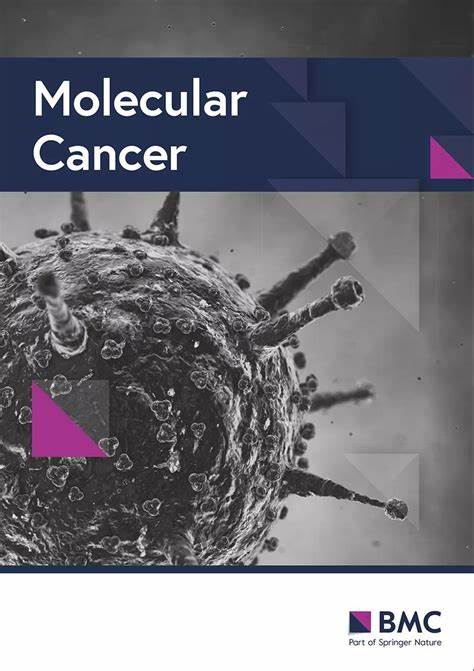BRD9-p53-E2F1 circuit orchestrates cell growth and DNA damage repair in gastric cancer
IF 33.9
1区 医学
Q1 BIOCHEMISTRY & MOLECULAR BIOLOGY
引用次数: 0
Abstract
BRD9 is involved in multiple physiological and pathological pathways, yet its functional role and molecular mechanisms in gastric cancer (GC) remain largely unexplored. Addressing this knowledge gap is critical given the persistent global mortality burden of GC and the limited efficacy of current therapeutic strategies. BRD9 expression in GC patients was systematically analyzed using immunohistochemical (IHC) assays and transcriptomic datasets. Comprehensive functional validation, employing cellular and murine tumor models, elucidated BRD9’s role in GC progression. Molecular pathways underlying BRD9-mediated gastric carcinogenesis were delineated through integrated approaches, including RNA sequencing, co-immunoprecipitation (co-IP), subcellular fractionation, and luciferase reporter assays. BRD9 was significantly overexpressed in GC and associated with poor patient prognosis. Functionally, BRD9 promoted GC cell proliferation and enhanced DNA damage repair capacity. Mechanistically, elevated BRD9 expression inhibited p53 nuclear translocation via direct binding, subsequently activating the E2F transcription factor family. Notably, we identified that E2F1 directly bound to and transactivated the BRD9 promoter, establishing a positive feedback loop that sustains BRD9 expression. Additionally, BRD9 knockdown sensitized GC cells to cisplatin and oxaliplatin treatment. These findings highlight the critical role of BRD9 in GC progression and its therapeutic potential. The BRD9-p53-E2F1 axis acts as a crucial regulator of GC cell proliferation and DNA damage response. Targeting BRD9 pharmacologically could be a novel therapeutic approach to enhance chemotherapy efficacy and improve treatment outcomes in GC patients.BRD9-p53-E2F1回路协调胃癌细胞生长和DNA损伤修复
BRD9参与多种生理和病理通路,但其在胃癌(GC)中的功能作用和分子机制仍未被充分研究。鉴于胃癌持续的全球死亡率负担和当前治疗策略的有限疗效,解决这一知识差距至关重要。使用免疫组化(IHC)和转录组学数据集系统分析GC患者BRD9的表达。利用细胞和小鼠肿瘤模型进行综合功能验证,阐明了BRD9在GC进展中的作用。通过RNA测序、共免疫沉淀(co-IP)、亚细胞分离和荧光素酶报告基因检测等综合方法,描绘了brd9介导的胃癌发生的分子途径。BRD9在胃癌中显著过表达,与患者预后不良相关。功能上,BRD9促进GC细胞增殖,增强DNA损伤修复能力。机制上,BRD9表达升高通过直接结合抑制p53核易位,随后激活E2F转录因子家族。值得注意的是,我们发现E2F1直接结合并反激活了BRD9启动子,建立了一个维持BRD9表达的正反馈循环。此外,BRD9敲低使GC细胞对顺铂和奥沙利铂治疗敏感。这些发现强调了BRD9在胃癌进展中的关键作用及其治疗潜力。BRD9-p53-E2F1轴是GC细胞增殖和DNA损伤反应的重要调节因子。以BRD9为靶点的药物治疗可能是提高胃癌患者化疗疗效和改善治疗结果的一种新的治疗方法。
本文章由计算机程序翻译,如有差异,请以英文原文为准。
求助全文
约1分钟内获得全文
求助全文
来源期刊

Molecular Cancer
医学-生化与分子生物学
CiteScore
54.90
自引率
2.70%
发文量
224
审稿时长
2 months
期刊介绍:
Molecular Cancer is a platform that encourages the exchange of ideas and discoveries in the field of cancer research, particularly focusing on the molecular aspects. Our goal is to facilitate discussions and provide insights into various areas of cancer and related biomedical science. We welcome articles from basic, translational, and clinical research that contribute to the advancement of understanding, prevention, diagnosis, and treatment of cancer.
The scope of topics covered in Molecular Cancer is diverse and inclusive. These include, but are not limited to, cell and tumor biology, angiogenesis, utilizing animal models, understanding metastasis, exploring cancer antigens and the immune response, investigating cellular signaling and molecular biology, examining epidemiology, genetic and molecular profiling of cancer, identifying molecular targets, studying cancer stem cells, exploring DNA damage and repair mechanisms, analyzing cell cycle regulation, investigating apoptosis, exploring molecular virology, and evaluating vaccine and antibody-based cancer therapies.
Molecular Cancer serves as an important platform for sharing exciting discoveries in cancer-related research. It offers an unparalleled opportunity to communicate information to both specialists and the general public. The online presence of Molecular Cancer enables immediate publication of accepted articles and facilitates the presentation of large datasets and supplementary information. This ensures that new research is efficiently and rapidly disseminated to the scientific community.
 求助内容:
求助内容: 应助结果提醒方式:
应助结果提醒方式:


